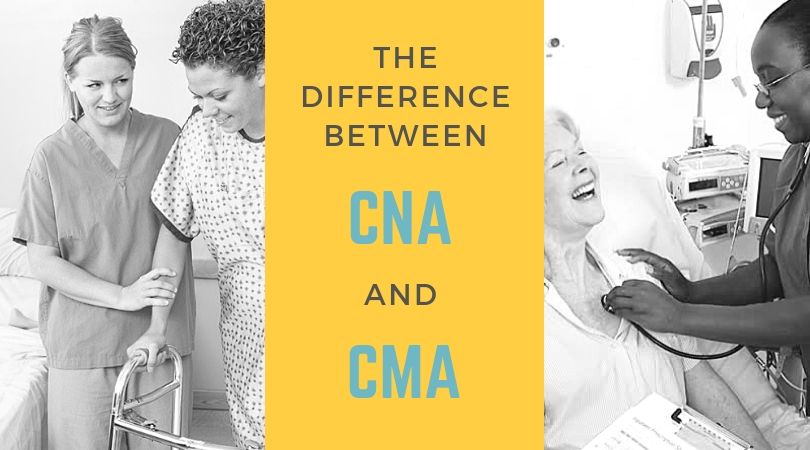What Is the Difference Between a CNA and CMA?

Certified nursing assistants (CNAs) and certified medical assistants (CMAs) are both allied health care service providers or professionals who work with patients of all ages and physical conditions. While both positions work in healthcare assistance, they have different responsibilities, duties, and educational and certification requirements.
What Does a CNA Do?
A certified nursing assistant provides care to patients under the supervision of a registered nurse or a licensed nurse practitioner rather than under the direction of a doctor. CNAs perform direct assistance with patients, do not prescribe medications or treatments, and perform only limited autonomous tasks under RN supervision.
CNA duties may include:
- Fulfilling basic needs and daily activities of patients, such as having meals, bathing, toileting, and dressing.
- Observing patient physical and emotional status.
- Taking notes of patient vitals signs.
- Maintaining the environment of the patient, such as making beds, cleaning rooms, and ensuring appropriate meals are served to the patient. This may also include gathering, setting up, or storing medical equipment properly.
CNA Work Environment
CNAs are slightly more autonomous than CMAs and are able to perform more tasks without direct supervision. As a result, CNAs can find employment in a greater variety of places than CMAs and have more overall flexibility in terms of finding a job.
CNAs typically work in:
- Hospitals;
- Nursing or living homes;
- Daycare centers;
- Government institutions;
- Private practices;
- Traveling positions.
What Does a CMA Do?
Certified medical assistants (CMAs) typically work under the supervision of physicians and doctors and perform the duties delegated to them. CMAs are directly involved in patient care and assessment, do not prescribe medications or treatments (though they may describe them to patients), and may perform some tasks autonomously.
CMA duties may include administrative, clerical, clinical, and specialist duties such as:
- Answering calls, scheduling appointments, patient correspondence;
- Welcoming patients;
- Arranging hospital admissions and laboratory services;
- Updating and filing patient medical records
- Coding and filling out insurance forms;
- Billing and bookkeeping;
- Taking medical histories;
- Explaining treatments, medication, and diets to patients;
- Preparing patients for examinations and assisting physicians during the exam;
- Collecting and preparing lab specimens;
- Performing basic laboratory tests;
- Drawing blood;
- Removing sutures or changing dressings.
CMA Work Environment
Because CMAs work under the direct supervision of physicians, they tend to only find employment in places where physicians are also consistently present. As a result, they have less diversity of employers and less autonomy than CNAs.
CMAs typically work in:
- Physician or doctor offices;
- Urgent care centers;
- Hospitals.
Can a Medical Assistant Work as a CNA, or Vice Versa?
In short, no. Each position is unique in its job duties, responsibilities, education requirements, and certifications. While some skills and experience may translate between the two jobs, transitioning from one career to the other would require additional education and certification.
CMA vs CNA Programs
To become a CMA or a CNA you must meet the specific educational and program requirements for each job.
CMA Training
To become a medical assistant typically takes one year for a certification degree, or two years to complete an associate’s degree program in medical assessment. The courses for the programs are typically offered in both online and traditional formats. However, in order to become eligible to sit for the exam to be certified, you must complete the program from an accredited school or institute. The school must have received its accreditation from the Commission on Accreditation of Allied Health Education Programs (CAAHEP) or the Accrediting Bureau of Health Education Schools (ABHES).
The required coursework includes anatomy and physiology, medical law and ethics, business computer application, medical billing and coding, medical terminology, clinical laboratory procedure, etc.
CNA Training
CNA program requirements vary from state to state and generally lasts 4-12 weeks up to 6 months. The whole program session is divided into two parts, a theoretical session, and a clinical session. The theoretical sessions educate students on how to perform direct patient care, including patient safety and documentation. The clinical session includes student learning on wound dressing, preparing patients for surgery, collecting urine samples, and more. CNA programs are approved at the state level, so it is important to ensure that the program you are enrolling in is approved for the state you intend to work in and that it is accredited by the Accreditation Commission for Education in Nursing (ACEN).
The required coursework of a CNA program includes human anatomy, CPR, communication skills, ergonomics, disease prevention, nutrition, medical procedures & first aid, and more. CNA training often covers many of the same skills as RNs, making CNA certification a popular first step for those wishing to ultimately become certified as RNs.
CMA vs CNA Examination and Certification
To work as a CMA or CNA you must pass an examination to become certified.
CMA
After completing an accredited CMA program graduates are required to take the American Association of Medical Assistants exam to become certified. The exam consists of 200 multiple-choice questions. Candidates need to complete it within four segments of 40 minutes each. A major portion of the test is composed of medical terminology. The remaining part consists of questions that reflect learnings from the coursework and program. Questions may be posed in different formats such as fill-in-the-blank, matching cases, and true/false.
A CMA certification is valid for 60 months from the date of issue. CMAs may recertify by continuing education credits. CMAs must obtain 60 recertification credits, 30 of which must be AAMA approved continuing education units (CEUs). The CEUs should be broken down as follows:
- 10 administrative;
- 10 clinical;
- 10 general;
- 30 of any combination of the above categories.
CMAs may also recertify by retaking the CMA (AAMA) Certification Exam.
CNA
After completion of the program, graduates must pass the National Nurse Aide Assessment Exam, or sit a state CNA certification exam to become certified. The exam tests the knowledge that you gained throughout the CNA program including; the role of a nursing assistant, nursing skills, and physical care skills. The tests vary by state but will have two sections. The written portion is usually administered by a proctor and will include multiple-choice questions covering topics such as medical terminology, CNA roles and responsibilities, anatomy and physiology, and more, which must be completed within two hours. The clinical section is practical ands typically proctored by a nurse or doctor. The clinical section may include a few tasks that must be completed within a specific time frame. The tasks may include recording and measuring blood pressure, handwashing, or helping a patient bathe or eat. Graduates must pass both exams to become eligible for licensure.
CNA certification is typically valid for two years and may have individual state requirements. Recertification may include a required number of active employment hours and a renewal form and fee. If a CNA has not met the renewal requirements, or their certification has been expired for two or more years, the applicant may need to resit the competency exam.
Medical Assistant vs CNA Salary and Career Outlook
Healthcare occupations are projected to add about 1.9 million new jobs, growing at an above-average rate of 14% from 2018 to 2028 due to an aging population and a greater demand for health care services, including CMAs and CNAs.
CMA
The demand and outlook for certified medical assistants are expected to grow at 23% from 2018 to 2028 as a result of increasing demand for medical services. The average median pay of a certified medical assistant was $34,800 per year or $16.73 per hour in 2019 but may vary by state.
CNA
The demand and outlook for certified nursing assistants are expected to grow at 9% from 2018 to 2028 as a result of increasing demand for medical services, and the need to care for the aging baby-boom population. The average median pay of a certified nursing assistant was $29,640 per year or $14.25 per hour in 2019 but may vary by state.
CMA vs CNA Career: Which Is Better?
Both CMAs and CNAs provide crucial care and support to patients and the medical industry. Each career requires a unique education and certification and will result in different duties and responsibilities of patient care. CNAs tend towards more personalized care of patients and are usually under the direct supervision of an RN. CMAs work closely with doctors or physicians and may focus on different aspects of care from administrative to clinical.
Either way, working as an assistant will tend to provide less autonomy, and is thus often a springboard for those wishing to advance their clinical skills and become an RN. Among the many benefits enjoyed by RNs are higher average pay, more diverse work environments, opportunities for specialization, and greater clinical autonomy. Ultimately, choosing the right career path will depend on the level of education you wish to pursue, as well as the daily responsibilities you wish to perform.





